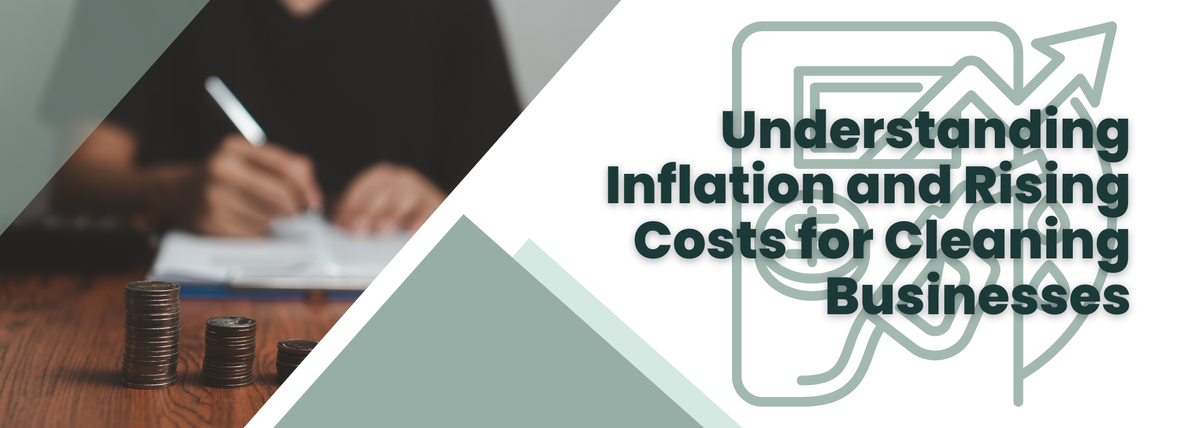Understanding Inflation and Rising Costs for Cleaning Businesses

The cleaning industry faces various challenges, especially with recent increases in inflation and living expenses making things tougher for business owners. Those running residential cleaning services and smaller companies are feeling these changes the most. Every part of their work—from buying supplies to paying employees to setting prices—is affected.
In this guide, we’ll explore how rising costs are changing things for cleaning businesses. Plus, we'll share simple strategies that can help you not only survive but also grow during these tough times.

Understanding How Inflation Affects Your Cleaning Business
Inflation happens when the prices for goods and services go up, which means your money doesn’t buy as much as it used to. For cleaning businesses, this means you’re spending more on things like supplies, fuel, and wages. Let’s see how these areas are impacted:
1. Rising Costs of Supplies
To provide excellent services, you need cleaning products and tools. But, due to disruptions in supply chains and higher costs to make these items, prices for things like disinfectants and vacuum parts have gone up.
- For instance: An all-purpose cleaner that used to be $15 might now cost $20 or more. These increases can add up and affect your profits.

2. Higher Fuel Prices
Many cleaning businesses need vehicles to reach clients. When fuel prices go up, transportation costs can become a major challenge.
- The effect: Higher fuel costs might make you reconsider how far you travel for work or alter your schedules.
3. Increased Labour Costs
Your employees are vital to your cleaning business. With inflation, living costs rise, making workers ask for higher wages.
- Fact: Recent figures show that hourly wages for cleaning staff have risen by 10-15% over the past year.

4. Shrinking Profit Margins
Inflation can force you to make tough choices: either raise your prices and risk losing customers, or keep prices the same and earn less profit. This can be particularly challenging for small businesses.
Challenges Small Cleaning Businesses Face
While big companies might handle these changes better, smaller businesses face unique challenges:
- Less bargaining power: Small businesses may not be able to negotiate big discounts with suppliers.
- Price-sensitive clients: Residential clients, feeling financial strain themselves, might push back against higher rates.
- Administrative strain: Without the right tools, managing costs and changing prices can become too much to handle.

Practical Tips for Navigating Inflation
Even with these hurdles, there are ways for cleaning businesses to adapt and become stronger. Here are some straightforward strategies:
1. Reviewing and Adjusting Prices Regularly
Make sure your prices reflect the real cost of running your business. Look at your expenses frequently and change rates when needed.
- Tip: Talk to your clients honestly about any price changes. Highlight the value you offer, like quality and dependability.
2. Streamlining Routes to Save Fuel
You can't control fuel prices, but you can plan better to reduce costs.
- Use route planning tools to cut unnecessary travel.
- Book appointments by area to cut down on driving time.

3. Offering High-Value Services
Services like deep cleaning or eco-friendly options can attract clients willing to pay more.
- Why this helps: People often pay extra for services that meet their specific needs or values.
4. Talking to Your Suppliers
Ask suppliers if you can get better prices or discounts for buying in bulk. Good relations with vendors can mean perks like quick shipping or special deals.
5. Embracing Technology for Better Efficiency
Automation and software can make your operations run more smoothly.
- Use scheduling software to save time spent on bookings.
- Accounting tools help manage costs and highlight ways to save money.
- Client management platforms keep you organized and maintain high service levels.

Real-life Examples of Adaptation
Example: Successfully Increasing Prices
Sarah, who cleans homes, faced rising costs for supplies and needed to pay higher wages. She transparently informed her clients about her price increases via email.
- Result: Though a few clients left, most stayed, valuing her good service and professionalism, which helped her keep profit levels stable.
Example: Improving Efficiency
Tom, who manages a small cleaning team, saw wasted travel time. By using route optimization software, he cut unnecessary driving by 25%.
- Result: Tom saved money on fuel and grew his client base without having to work longer hours.

Looking Ahead for Long-term Success
While immediate steps are crucial, planning for the long term is just as important:
- Build a financial cushion: Save part of your profits for unexpected costs.
- Expand your offerings: Consider selling additional services or products, like cleaning supply kits for clients between visits.
- Keep learning: Stay updated on market changes and new technology to enhance how your business runs.
Final Thoughts
Dealing with inflation and rising costs means cleaning business owners need to be creative and adapt quickly. Even if the future seems uncertain, focusing on efficiency, having open communication with clients, and setting smart prices will help you manage these economic changes.
By embracing change proactively, your cleaning business can thrive and succeed, even in challenging times.




